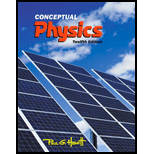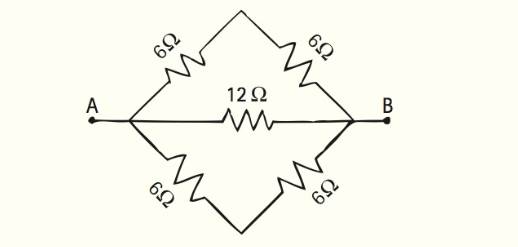
Conceptual Physics (12th Edition)
12th Edition
ISBN: 9780321909107
Author: Paul G. Hewitt
Publisher: PEARSON
expand_more
expand_more
format_list_bulleted
Concept explainers
Textbook Question
Chapter 23, Problem 120RCQ
(a) What single resistor would be equivalent to the resistors in this arrangement? (b) If 24 volts were applied across points A and B, how much current would there be in the circuit? (c) How much current in the 12-ohm resistor?

Expert Solution & Answer
Want to see the full answer?
Check out a sample textbook solution
Students have asked these similar questions
please help with the abstract. Abstract - This document outlines the format of the lab report and describes the Excel assignment. The abstract should be a short paragraph that very briefly includes the experiment objective, method, result and conclusion. After skimming the abstract, the reader should be able to decide whether they want to keep reading your work. Both the format of the report and the error analysis are to be followed. Note that abstract is not just the introduction and conclusion combined, but rather the whole experiment in short including the results. I have attacted the theory.
Using the Experimental Acceleration due to Gravity values from each data table, Data Tables 1, 2, and 3; determine the Standard Deviation, σ, mean, μ, variance, σ2 and the 95% Margin of Error (Confidence Level) Data: Ex. Acc. 1: 12.29 m/s^2. Ex. Acc. 2: 10.86 m/s^2, Ex. Acc. 3: 9.05 m/s^2
In the Super Smash Bros. games the character Yoshi’s has a “ground pound” down special move where he launches himself downward to attack an enemy beneath him. A) If Yoshi flings himself downwards at 9.76 miles per hour to hit an enemy 10.5 m below him, how fast is Yoshi traveling when he hits the enemy? 1 mile = 1609 m B) How much time does it take Yoshi to hit the enemy beneath him?
Chapter 23 Solutions
Conceptual Physics (12th Edition)
Ch. 23 - Prob. 1RCQCh. 23 - What condition is necessary for the sustained flow...Ch. 23 - Prob. 3RCQCh. 23 - Prob. 4RCQCh. 23 - Prob. 5RCQCh. 23 - Prob. 6RCQCh. 23 - Does electric charge flow across a circuit or...Ch. 23 - Prob. 8RCQCh. 23 - Does heating a metal wire increase or decrease its...Ch. 23 - Prob. 10RCQ
Ch. 23 - Prob. 11RCQCh. 23 - Prob. 12RCQCh. 23 - Prob. 13RCQCh. 23 - Prob. 14RCQCh. 23 - Prob. 15RCQCh. 23 - Prob. 16RCQCh. 23 - Prob. 17RCQCh. 23 - Prob. 18RCQCh. 23 - Prob. 19RCQCh. 23 - Prob. 20RCQCh. 23 - Prob. 21RCQCh. 23 - Prob. 22RCQCh. 23 - Prob. 23RCQCh. 23 - Prob. 24RCQCh. 23 - Prob. 25RCQCh. 23 - Prob. 26RCQCh. 23 - Prob. 27RCQCh. 23 - Prob. 28RCQCh. 23 - Prob. 29RCQCh. 23 - Prob. 30RCQCh. 23 - Prob. 31RCQCh. 23 - Prob. 32RCQCh. 23 - Prob. 33RCQCh. 23 - Prob. 34RCQCh. 23 - Prob. 35RCQCh. 23 - 36. Send a letter to Grandma and convince her that...Ch. 23 -
Ohm’s law:
37. A toaster has a heating element...Ch. 23 - Prob. 38RCQCh. 23 - 39. Calculate the current in the 240-Ώ filament of...Ch. 23 - Power
40. An electric toy draws 0.5 A from a...Ch. 23 - 41. Calculate the power of a hair dryer that...Ch. 23 - 42. What is the effect on the current in a wire if...Ch. 23 - Prob. 43RCQCh. 23 - 44. Rearrange the equation current = voltage/...Ch. 23 - Prob. 45RCQCh. 23 - 46. The total charge that an automobile battery...Ch. 23 - Prob. 47RCQCh. 23 - 48. A 4-W night-light is plugged into a 120-V...Ch. 23 - Prob. 49RCQCh. 23 - 50. Show in the preceding problem that 540 C of...Ch. 23 - Prob. 51RCQCh. 23 - 52. Rank the circuits illustrated according to the...Ch. 23 - 53. The bulbs shown are identical. An ammeter is...Ch. 23 - 54. All bulbs are identical in the circuits shown....Ch. 23 - 55. All bulbs are identical in the circuits shown....Ch. 23 - 56. Consider the three parts of the circuit: A,...Ch. 23 - Prob. 57RCQCh. 23 - Prob. 58RCQCh. 23 - Prob. 59RCQCh. 23 - 60. Consider a circuit with a main wire that...Ch. 23 - Prob. 61RCQCh. 23 - Prob. 62RCQCh. 23 - 63. The circuit within an incandescent lamp is...Ch. 23 - Prob. 64RCQCh. 23 - 65. How much energy is given to each coulomb of...Ch. 23 - Prob. 66RCQCh. 23 - Prob. 67RCQCh. 23 - 68. In which of the circuits shown does a current...Ch. 23 - Prob. 69RCQCh. 23 - 70. Something gets “used up” in a battery that...Ch. 23 - Prob. 71RCQCh. 23 - Prob. 72RCQCh. 23 - Prob. 73RCQCh. 23 - 74. Why is the current in an incandescent bulb...Ch. 23 - Prob. 75RCQCh. 23 - 76. Why are all compact fluorescent lamps more...Ch. 23 - Prob. 77RCQCh. 23 - Prob. 78RCQCh. 23 - Prob. 79RCQCh. 23 - 80. What causes electric shock: current or...Ch. 23 - Prob. 81RCQCh. 23 - Prob. 82RCQCh. 23 - Prob. 83RCQCh. 23 - 84. As more lines are opened at a fast-food...Ch. 23 - Prob. 85RCQCh. 23 - 86. Which is the same for a 10-Ω and a 20-Ω...Ch. 23 - Prob. 87RCQCh. 23 - The damaging effects of electric shock result from...Ch. 23 - Prob. 89RCQCh. 23 - Prob. 90RCQCh. 23 - 91. Which will do less damage: plugging a 110-V...Ch. 23 - Prob. 92RCQCh. 23 - Prob. 93RCQCh. 23 - Prob. 94RCQCh. 23 - Prob. 95RCQCh. 23 - Prob. 96RCQCh. 23 - 97. What happens to the brightness of bulb A when...Ch. 23 - Prob. 98RCQCh. 23 - 99. In the circuit shown, how do the brightness’s...Ch. 23 - Prob. 100RCQCh. 23 - Prob. 101RCQCh. 23 - Prob. 102RCQCh. 23 - 103. When a pair of identical resistors are...Ch. 23 - Prob. 104RCQCh. 23 - Prob. 105RCQCh. 23 - 106. Are these three circuits equivalent? Why or...Ch. 23 - Prob. 107RCQCh. 23 - Prob. 108RCQCh. 23 - Prob. 109RCQCh. 23 - Prob. 110RCQCh. 23 - To connect a pair of resistors so that their...Ch. 23 - Prob. 112RCQCh. 23 - Prob. 113RCQCh. 23 - Prob. 114RCQCh. 23 - Prob. 115RCQCh. 23 - Prob. 116RCQCh. 23 - Prob. 117RCQCh. 23 - Prob. 118RCQCh. 23 - Prob. 119RCQCh. 23 - (a) What single resistor would be equivalent to...Ch. 23 - 121. Three 6-ohm resistors are arranged in a...
Knowledge Booster
Learn more about
Need a deep-dive on the concept behind this application? Look no further. Learn more about this topic, physics and related others by exploring similar questions and additional content below.Similar questions
- No chatgpt pls will upvotearrow_forward1.62 On a training flight, a Figure P1.62 student pilot flies from Lincoln, Nebraska, to Clarinda, Iowa, next to St. Joseph, Missouri, and then to Manhattan, Kansas (Fig. P1.62). The directions are shown relative to north: 0° is north, 90° is east, 180° is south, and 270° is west. Use the method of components to find (a) the distance she has to fly from Manhattan to get back to Lincoln, and (b) the direction (relative to north) she must fly to get there. Illustrate your solutions with a vector diagram. IOWA 147 km Lincoln 85° Clarinda 106 km 167° St. Joseph NEBRASKA Manhattan 166 km 235° S KANSAS MISSOURIarrow_forwardPlz no chatgpt pls will upvotearrow_forward
- 3.19 • Win the Prize. In a carnival booth, you can win a stuffed gi- raffe if you toss a quarter into a small dish. The dish is on a shelf above the point where the quarter leaves your hand and is a horizontal dis- tance of 2.1 m from this point (Fig. E3.19). If you toss the coin with a velocity of 6.4 m/s at an angle of 60° above the horizontal, the coin will land in the dish. Ignore air resistance. (a) What is the height of the shelf above the point where the quarter leaves your hand? (b) What is the vertical component of the velocity of the quarter just before it lands in the dish? Figure E3.19 6.4 m/s 2.1arrow_forwardCan someone help me answer this thank you.arrow_forward1.21 A postal employee drives a delivery truck along the route shown in Fig. E1.21. Determine the magnitude and direction of the resultant displacement by drawing a scale diagram. (See also Exercise 1.28 for a different approach.) Figure E1.21 START 2.6 km 4.0 km 3.1 km STOParrow_forward
- help because i am so lost and it should look something like the picturearrow_forward3.31 A Ferris wheel with radius Figure E3.31 14.0 m is turning about a horizontal axis through its center (Fig. E3.31). The linear speed of a passenger on the rim is constant and equal to 6.00 m/s. What are the magnitude and direction of the passenger's acceleration as she passes through (a) the lowest point in her circular motion and (b) the high- est point in her circular motion? (c) How much time does it take the Ferris wheel to make one revolution?arrow_forward1.56 ⚫. Three horizontal ropes pull on a large stone stuck in the ground, producing the vector forces A, B, and C shown in Fig. P1.56. Find the magnitude and direction of a fourth force on the stone that will make the vector sum of the four forces zero. Figure P1.56 B(80.0 N) 30.0 A (100.0 N) 53.0° C (40.0 N) 30.0°arrow_forward
arrow_back_ios
SEE MORE QUESTIONS
arrow_forward_ios
Recommended textbooks for you
 Glencoe Physics: Principles and Problems, Student...PhysicsISBN:9780078807213Author:Paul W. ZitzewitzPublisher:Glencoe/McGraw-Hill
Glencoe Physics: Principles and Problems, Student...PhysicsISBN:9780078807213Author:Paul W. ZitzewitzPublisher:Glencoe/McGraw-Hill
 College PhysicsPhysicsISBN:9781305952300Author:Raymond A. Serway, Chris VuillePublisher:Cengage Learning
College PhysicsPhysicsISBN:9781305952300Author:Raymond A. Serway, Chris VuillePublisher:Cengage Learning College PhysicsPhysicsISBN:9781938168000Author:Paul Peter Urone, Roger HinrichsPublisher:OpenStax College
College PhysicsPhysicsISBN:9781938168000Author:Paul Peter Urone, Roger HinrichsPublisher:OpenStax College Physics for Scientists and Engineers: Foundations...PhysicsISBN:9781133939146Author:Katz, Debora M.Publisher:Cengage Learning
Physics for Scientists and Engineers: Foundations...PhysicsISBN:9781133939146Author:Katz, Debora M.Publisher:Cengage Learning College PhysicsPhysicsISBN:9781285737027Author:Raymond A. Serway, Chris VuillePublisher:Cengage Learning
College PhysicsPhysicsISBN:9781285737027Author:Raymond A. Serway, Chris VuillePublisher:Cengage Learning

Glencoe Physics: Principles and Problems, Student...
Physics
ISBN:9780078807213
Author:Paul W. Zitzewitz
Publisher:Glencoe/McGraw-Hill


College Physics
Physics
ISBN:9781305952300
Author:Raymond A. Serway, Chris Vuille
Publisher:Cengage Learning

College Physics
Physics
ISBN:9781938168000
Author:Paul Peter Urone, Roger Hinrichs
Publisher:OpenStax College

Physics for Scientists and Engineers: Foundations...
Physics
ISBN:9781133939146
Author:Katz, Debora M.
Publisher:Cengage Learning

College Physics
Physics
ISBN:9781285737027
Author:Raymond A. Serway, Chris Vuille
Publisher:Cengage Learning
Circuits, Voltage, Resistance, Current - Physics 101 / AP Physics Review with Dianna Cowern; Author: Physics Girl;https://www.youtube.com/watch?v=q8X2gcPVwO0;License: Standard YouTube License, CC-BY